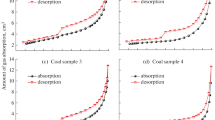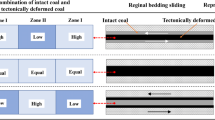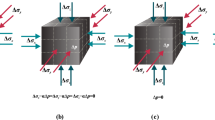Abstract
With increasing demands for coal resources, coal has been gradually mined in deep coal seams. Due to high gas content, pressure and in situ stress, deep coal seams show great risks of coal and gas outburst. Protective coal seam mining, as a safe and effective method for gas control, has been widely used in major coal-producing countries in the world. However, at present, the relevant problems, such as gas seepage characteristics and optimization of gas drainage borehole layout in protective coal seam mining have been rarely studied. Firstly, by combining with formulas for measuring and testing permeability of coal and rock mass in different stress regimes and failure modes in the laboratory, this study investigated stress–seepage coupling laws by using built-in language Fish of numerical simulation software FLAC3D. In addition, this research analyzed distribution characteristics of permeability in a protected coal seam in the process of protective coal seam mining. Secondly, the protected coal seam was divided into a zone with initial permeability, a zone with decreasing permeability, and permeability increasing zones 1 and 2 according to the changes of permeability. In these zones, permeability rises the most in the permeability increasing zone 2. Moreover, by taking Shaqu Coal Mine, Shanxi Province, China as an example, layout of gas drainage boreholes in the protected coal seam was optimized based on the above permeability-based zoning. Finally, numerical simulation and field application showed that gas drainage volume and concentration rise significantly after optimizing borehole layout. Therefore, when gas is drained through boreholes crossing coal seams during the protective coal seam mining in other coal mines, optimization of borehole layout in Shaqu Coal Mine has certain reference values.














Similar content being viewed by others
References
Busch, A., & Gensterblum, Y. (2011). CBM and CO2-ECBM related sorption processes in coal, a review. International Journal of Coal Geology, 87(2), 49–71.
Chen, H., Cheng, Y., Ren, T., Zhou, H., & Liu, Q. (2014). Permeability distribution characteristics of protected coal seams during unloading of the coal body. International Journal of Rock Mechanics and Mining Sciences, 71, 105–116.
Guo, H., Cheng, Y., Yuan, L., Wang, L., & Zhou, H. (2016). Unsteady-state diffusion of gas in coals and its relationship with coal pore structure. Energy & Fuels, 30(9), 7014–7024.
Guo, H., Todhunter, C., Qu, Q., & Qin, Z. (2015). Longwall horizontal gas drainage through goaf pressure control. International Journal of Coal Geology, 150–151, 276–286.
Jin, K., et al. (2016a). Evaluation of the remote lower protective seam mining for coal mine gas control, a typical case study from the Zhuxianzhuang Coal Mine, Huaibei Coalfield, China. Journal of Natural Gas Science and Engineering, 33, 44–55.
Jin, K., et al. (2016b). Experimental investigation of pore structure damage in pulverized coal, implications for methane adsorption and diffusion characteristics. Energy & Fuels, 30(12), 10383–10395.
Li, X., et al. (2018). Pattern recognition of mine microseismic and blasting events based on wave fractal features. Fractals, 26(03), 1850029.
Liu, H., Lin, B., & Jiang, C. (2019). A new method for determining coal seam permeability redistribution induced by roadway excavation and its applications. Process Safety and Environmental Protection, 131, 1–8.
Liu, H., Liu, H., & Cheng, Y. (2014). The elimination of coal and gas outburst disasters by ultrathin protective seam drilling combined with stress-relief gas drainage in Xinggong coalfield. Journal of Natural Gas Science and Engineering, 21, 837–844.
Liu, S., et al. (2020). Mechanical and acoustic emission characteristics of coal at temperature impact. Natural Resources Research, 29(3), 1755–1772.
McCollum, D., Bauer, N., Calvin, K., Kitous, A., & Riahi, K. (2014). Fossil resource and energy security dynamics in conventional and carbon-constrained worlds. Climatic Change, 123(3), 413–426.
Pan, R., Cheng, Y., Yuan, L., Yu, M., & Dong, J. (2014). Effect of bedding structural diversity of coal on permeability evolution and gas disasters control with coal mining. Natural Hazards, 73(2), 531–546.
Pan, W., Nie, X., & Li, X. (2019). Effect of premining on hard roof distress behavior, a case study. Rock Mechanics and Rock Engineering, 52(6), 1871–1885.
Song, Y., Zou, Q., Su, E., Zhang, Y., & Sun, Y. (2020). Changes in the microstructure of low-rank coal after supercritical CO2 and water treatment. Fuel, 279, 118493.
Su, E. et al. (2020). Effects of cyclic saturation of supercritical CO2 on the pore structures and mechanical properties of bituminous coal, an experimental study. Journal of CO2 Utilization, 40, 101208.
Su, E., Liang, Y., Li, L., Zou, Q., & Niu, F. (2018). Laboratory study on changes in the pore structures and gas desorption properties of intact and tectonic coals after supercritical CO2 treatment, implications for coalbed methane recovery. Energies, 11(12), 3419.
Su, E., Liang, Y., Zou, Q., Niu, F., & Li, L. (2019). Analysis of effects of CO2 injection on coalbed permeability, implications for coal seam CO2 sequestration. Energy & Fuels, 33(7), 6606–6615.
Wang, H., Cheng, Y., & Yuan, L. (2013). Gas outburst disasters and the mining technology of key protective seam in coal seam group in the Huainan coalfield. Natural Hazards, 67(2), 763–782.
Wang, J. A., & Park, H. D. (2002). Fluid permeability of sedimentary rocks in a complete stress–strain process. Engineering Geology, 63(3), 291–300.
Wang, K., Zhang, J., Cai, B., & Yu, S. (2019). Emission factors of fugitive methane from underground coal mines in China, Estimation and uncertainty. Applied Energy, 250, 273–282.
Wang, X., et al. (2020). Pore structure and diffusion characteristics of intact and tectonic coals, Implications for selection of CO2 geological sequestration site. Journal of Natural Gas Science and Engineering, 81, 103388.
Xie, J., Liang, Y., Zou, Q., Wang, Z., & Li, X. (2019). Prediction model for isothermal adsorption curves based on adsorption potential theory and adsorption behaviors of methane on granular coal. Energy & Fuels, 33(3), 1910–1921.
Xue, Y., et al. (2016). Quantitative evaluation of stress-relief and permeability-increasing effects of overlying coal seams for coal mine methane drainage in Wulan coal mine. Journal of Natural Gas Science and Engineering, 32, 122–137.
Yang, T. H., et al. (2011). Stress–damage–flow coupling model and its application to pressure relief coal bed methane in deep coal seam. International Journal of Coal Geology, 86(4), 357–366.
Yao, B., Ma, Q., Wei, J., Ma, J., & Cai, D. (2016). Effect of protective coal seam mining and gas extraction on gas transport in a coal seam. International Journal of Mining Science and Technology, 26(4), 637–643.
Yin, G., Li, M., Wang, J. G., Xu, J., & Li, W. (2015). Mechanical behavior and permeability evolution of gas infiltrated coals during protective layer mining. International Journal of Rock Mechanics and Mining Sciences, 80, 292–301.
Yuan, L. (2009). Technique of coal mining and gas extraction without coal pillar in multi-seam with low permeability. Journal of Coal Science and Engineering (China), 15(2), 120–128.
Zhang, M., Shimada, H., Sasaoka, T., Matsui, K., & Dou, L. (2014). Evolution and effect of the stress concentration and rock failure in the deep multi-seam coal mining. Environmental Earth Sciences, 72(3), 629–643.
Zhang, B., Sun, H., Liang, Y., Wang, K., & Zou, Q. (2020). Characterization and quantification of mining-induced fractures in overlying strata, implications for coalbed methane drainage. Natural Resources Research, 29(4), 2467–2480.
Zhang, Y., Tu, S., Bai, Q., & Li, J. (2013). Overburden fracture evolution laws and water-controlling technologies in mining very thick coal seam under water-rich roof. International Journal of Mining Science and Technology, 23(5), 693–700.
Zhang, C., Tu, S., Bai, Q., Yang, G., & Zhang, L. (2015). Evaluating pressure-relief mining performances based on surface gas venthole extraction data in longwall coal mines. Journal of Natural Gas Science and Engineering, 24, 431–440.
Zhang, C., Tu, S., & Zhang, L. (2019). Mining thickness determination of upper and lower protective coal seam in pressure relief mining. Geotechnical and Geological Engineering, 37(3), 1813–1827.
Zhou, H., et al. (2015). Methane and coal exploitation strategy of highly outburst-prone coal seam configurations. Journal of Natural Gas Science and Engineering, 23, 63–69.
Zou, Q., & Lin, B. (2018). Fluid–Solid coupling characteristics of gas-bearing coal subjected to hydraulic slotting, an experimental investigation. Energy & Fuels, 32(2), 1047–1060.
Zou, Q., Liu, H., Cheng, Z., Zhang, T., & Lin, B. (2020a). Effect of slot inclination angle and borehole-slot ratio on mechanical property of pre-cracked coal, implications for ECBM recovery using hydraulic slotting. Natural Resources Research, 29, 1705–1729.
Zou, Q., Liu, H., Zhang, Y., Li, Q., Fu, J., & Hu, Q. (2020b). Rationality evaluation of production deployment of outburst-prone coal mines, a case study of Nantong coal mine in Chongqing. China. Safety Science, 122, 104515.
Acknowledgments
The authors thank the editor and anonymous reviewers for their valuable advices. This work was financially supported by the National Natural Science Foundation of China (52074120 and 52074041), the Fundamental Research Funds for the Central Universities (3142019005 and 3142017107) and Key Project of the National Thirteen-Five Year Research Program of China (2016ZX05067005-001), which are gratefully acknowledged.
Author information
Authors and Affiliations
Corresponding authors
Rights and permissions
About this article
Cite this article
Cheng, Z., Pan, H., Zou, Q. et al. Gas Flow Characteristics and Optimization of Gas Drainage Borehole Layout in Protective Coal Seam Mining: A Case Study from the Shaqu Coal Mine, Shanxi Province, China. Nat Resour Res 30, 1481–1493 (2021). https://doi.org/10.1007/s11053-020-09775-4
Received:
Accepted:
Published:
Issue Date:
DOI: https://doi.org/10.1007/s11053-020-09775-4




